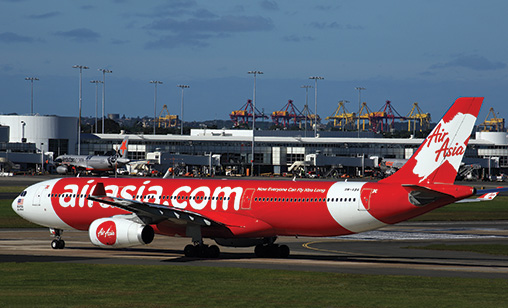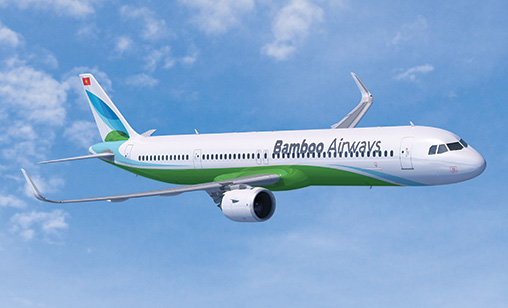Main Story
Asia’s low-cost carriers bet on international expansion
New generation aircraft will propel Asia-Pacific low-cost carriers onto long-haul routes that will carve out a new passenger sector at the region’s airlines.
September 1st 2018
When the region’s largest long haul low cost carrier, Malaysia’s AirAsia X, added 34 A330neos to its order book at the mid-July Farnborough Air Show the commitment underscored the determination of co-founder, Tony Fernandes, to return the low-cost airline group to Europe after a six-year hiatus. Read More »
Speaking at the Farnborough signing, AirAsia Group co-founder and AirAsia X Group chief executive, Kamarudin Meranun, made clear the group’s ambitions. “Long haul low-cost is something we strongly believe in. This order shows our confidence in the AirAsia X model,” he said.
 |
“We lobbied hard for the A330neo following the success of the A320neo. Working closely with Airbus, we are confident we have an aircraft that will allow us to expand our low fares offering beyond the Asia-Pacific to the rest of the world.”
With its expected deliveries, AirAsia X will have the capacity to go global as the order was in addition to the 66 A330neo it already has in the Airbus order book. The announcement also confirmed AirAsia X as the largest LCC wide body airline in the Asia-Pacific and the biggest customer of the type with 100 orders. All the A330neo ordered by AirAsia X are for the larger A330-900. The Malaysian carrier will take delivery of its first -900 in the fourth quarter of next year.
The aircraft can fly non-stop from Kuala Lumpur to Europe, including London, and will allow AirAsia X to offer very competitive fares between Europe and Asia.
There are 12 LHLCCs in the region that operate 92 wide body aircraft, including a fleet of 31 aircraft at three airlines in the AirAsia X Group.
Indications are that long-haul, low-cost flying, despite questions about its viability, will expand. In a July report, consultancy CAPA said: “Wide body LCCs have launched nine Asia-Europe routes in the last two years. There are five LHLCCs competing in the market compared with two in mid-2015.”
Three LHLCCs, Europe’s WOW, AirAsia X and Indonesia’s Lion Air Group will be flying between Asia and Europe by 2020. WOW will become the sixth LHLCC serving Asia-Europe from December 2018 with the introduction of Reykjavik to Delhi. Thai AirAsia is planning to fly to Eastern Europe in 2019 and Thai Lion Air is aiming for destinations to western Europe after 2020.
Ambitious VietJet has made no secret of its long-haul ambitions and is evaluating A330neos, A350s and B787s to extend its network to international cities. In June, a new Vietnamese LCC, Bamboo Airlines, agreed to buy 20 B787-9s at list prices of $5.6 billion to service its global ambitions.
 |
LCC Bamboo is owned by construction company FLC Group. Initially, it will fly within Vietnam before expanding to China, South Korea and Japan and onto Europe and North America.
“We are excited about introducing these new B787s to our fleet as we prepare to launch long-haul operations to international markets,” said FLC Group chairman, Trinh Van Quyet.. “Our long-term vision is to connect Vietnam to key markets within Asia, Europe and North America. The capabilities of these new state-of-the-art Dreamliners will help us achieve our goals.”
China also is in the game with Hainan Airlines subsidiary, Beijing Capital Airlines, now flying to London and Vancouver. It has six A330-200s with one more to be delivered, four A330-300s with another two to arrive at the carrier and an order for two A350-900s. All the aircraft are earmarked for long haul expansion.
Asian airlines are not the only LHLCCs to fly between Europe and Asia. Apart from WOW, Norwegian Air serves Bangkok and Lufthansa-owned Eurowings flies between Thailand’s capital and Cologne. Both carriers are unlikely to be the last to expand their reach from Europe to Asia.
By year end, British Airways-led IAG’s LHLCC, LEVEL, will be operating to Boston, Montreal, New York Newark, Guadeloupe, Martinique, Buenos Aires, San Francisco Oakland and Punta Cana, along with a summer service to Los Angeles. Analysts believed it would not be long before the airline turned its attention to the Asia-Pacific, the world’s fastest growing airline market.
In the region, Singapore Airlines-owned LHLCC, Scoot, flies B787s to Athens and Berlin. Last month Japan Airlines formally announced a corporate LHLCC entity initially to be resourced with two B787s. It is planned to be launched in 2020 and has European and North American destinations on its radar.
The region’s pioneer LHLCC, Qantas-owned Jetstar, has held back from Europe, but it flies to Hawaii as do rival LCCs Cebu Pacific, Scoot, AirAsia and Korean Air-owned Jin Air.
 |
LHLCCs hold two per cent of Asia-Europe capacity and are not forecast to secure more than five per cent of the market in the foreseeable future. Intense competition from full service airlines, including the Gulf carriers, and rising fuel costs make the Asia-Europe market a challenging proposition for LHLCC entrants, analysts said.
An alternative view is that new aircraft types - the B787, A330neo and the A350 – are making long haul low-cost flying more viable because of lower operating and maintenance costs. The sector could grow beyond a five per cent market share.
AirAsia X will be the first airline in Asia to operate the A330neo, with deliveries scheduled to start in the final three months of 2019. The A330neo will operate out of AirAsia X bases in Malaysia, Thailand and Indonesia.
In a separate report last June, CAPA said 15 LHLCCs have been launched since 2012, including subsidiaries of Air Canada, Hainan Airlines, Korean Air, Lufthansa, Qantas, Singapore Airlines and IAG.
The LHLCC model has been around for a decade, but it is only recently that the size of the sector has started to be significant, CAPA said.
“It surpassed 500,000 seats a week in June 2017. While this represented only 0.5% of the global market, LHLCC business is growing rapidly and will account for more than 1% of the global market within the next year or two,” CAPA said.
“Malaysia has the largest amount of long haul low-cost capacity at approximately 7%, followed by Australia and Singapore at 4% each.”
LHLCC expansion in Asia is expected to be held back by familiar problems: airport and ATC congestion and slot shortages. On the other hand, the region’s rapidly expanding middle class and their penchant for budget travel is expected to drive growth of LHLCC business whatever the logistical barriers.
22 AirAsia X 18 Scoot 11 Jetstar 8 Beijing Capital Airlines 8 Cebu Pacific 7 Thai AirAsia X 5 NokScoot 4 Lion Air 4 Jin Air 3 Thai Lion Air 2 Indonesia AirAsia X 1 Lucky Air |